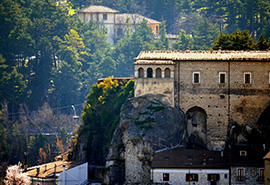The first evidence bearing witness to the existence of the castle dates back from the year 1136. Probably built on an ancient temple dedicated to the goddess Ceres, goddess of earth and prosperity. Due to successive enlargements of the original fort it has taken on the appearance of a complex structure. Situated on a huge rock the castle is built on three levels with a roof garden and a panoramic terrace, a central body around to which there are two side wings.
In 1216 these walls hosted St. Francis of Assisi, who travelled from Guardiagrele to Castelvecchio Subequo, his passage remained forever in the memory of the town and those who governed it. Florisenda, the daughter of Earl Thomas Vinciguerra, who was born here in 1239 , inspired by Saint Francis of Assisi, founded in Sulmona the monastery of St. Clare, which she herself was abbess.
Subsequently, in 1268 Charles of Anjou gave the castle to poet Sordello from Goito, in recognition of his loyalty, but it is legitimate to think that the elderly scholar had never spent any time in Palena.
In 1393 Ramondaccio Caldora took refuge in the castle of Palena chased by the troops of Ladislaus of Anjou and nothing they did enabled them to storm the castle. The same in 1464 when the troops of Ferdinand of Aragon put the castle under siege in order to capture Antonio Caldora.
The earthquakes of 1706 and 1933 damaged deeply the complex but the Second World War did not spare damage and destruction. Today the Duke’s Castle, after a long campaign of restoration has returned to life.

The first evidence bearing witness to the existence of the castle dates back from the year 1136. Probably built on an ancient temple dedicated to the goddess Ceres, goddess of earth and prosperity. Due to successive enlargements of the original fort it has taken on the appearance of a complex structure. Situated on a huge rock the castle is built on three levels with a roof garden and a panoramic terrace, a central body around to which there are two side wings.
In 1216 these walls hosted St. Francis of Assisi, who travelled from Guardiagrele to Castelvecchio Subequo, his passage remained forever in the memory of the town and those who governed it. Florisenda, the daughter of Earl Thomas Vinciguerra, who was born here in 1239 , inspired by Saint Francis of Assisi, founded in Sulmona the monastery of St. Clare, which she herself was abbess.
Subsequently, in 1268 Charles of Anjou gave the castle to poet Sordello from Goito, in recognition of his loyalty, but it is legitimate to think that the elderly scholar had never spent any time in Palena.
In 1393 Ramondaccio Caldora took refuge in the castle of Palena chased by the troops of Ladislaus of Anjou and nothing they did enabled them to storm the castle. The same in 1464 when the troops of Ferdinand of Aragon put the castle under siege in order to capture Antonio Caldora.
The earthquakes of 1706 and 1933 damaged deeply the complex but the Second World War did not spare damage and destruction. Today the Duke’s Castle, after a long campaign of restoration has returned to life.
















